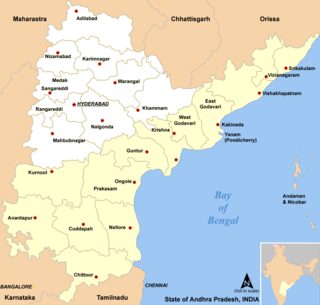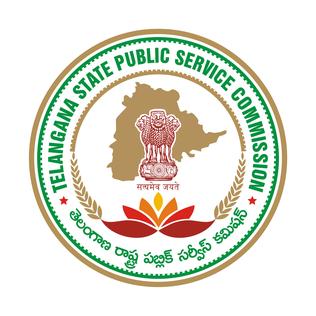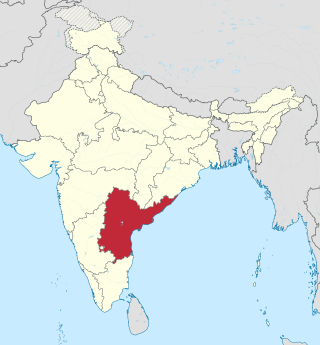
India is a federal union comprising 28 states and 8 union territories, for a total of 36 entities. The states and union territories are further subdivided into districts and smaller administrative divisions.

Telangana is a landlocked state in India situated in Southern part of the Indian peninsula on the high Deccan Plateau. It is the eleventh-largest state and the twelfth-most populated state in India as per 2011 census. On 2 June 2014, the area was separated from the northwestern part of Andhra Pradesh as the newly formed state of Telangana, with Hyderabad as its capital.

Rayalaseema is a geographic region in the Indian state of Andhra Pradesh. It comprises four southern districts of the State, from prior to the districts reorganisation in 2022, namely Kurnool, Anantapur, YSR and Chittoor. Four new districts were created from these, namely Sri Sathya Sai, Nandyal, Annamayya and Tirupati. As of 2011 census of India, the western four districts of the region had a population of 15,184,908 and cover an area of 71,060 km2 (27,440 sq mi).

Khammam district is a district in the eastern region of the Indian state of Telangana. The city of Khammam is the district headquarters. The district shares boundaries with Suryapet, Mahabubabad, Bhadradri districts and with Eluru and NTR districts.
The administrative divisions of India are subnational administrative units of India; they are composed of a nested hierarchy of administrative divisions.

Boianapalli Vinod Kumar is an Indian politician and former Member of Parliament, presently serving as Vice-chairman of Telangana State Planning Board. He represented the Karimnagar constituency of Telangana State in the 16th Lok Sabha (2014-2019) and Hanamkonda constituency in the 14th Lok Sabha (2004-2009). He is one of the founding members of the Telangana Rashtra Samithi (TRS) party and is presently a politburo member and served as party's deputy Floor Leader in the 16th Lok Sabha.

Ekkadu Srinivasan Lakshmi Narasimhan is an Indian former civil servant and politician who served as the first Governor of Telangana. He assumed office of the Governor of Andhra Pradesh on 28 December 2009 until 23 July 2019, making him the longest-serving governor of the state. Later he took on 2 June 2014 as the 1st Governor of Telangana as additional charge. A retired Indian Police Service officer, he previously served as the Director of the Intelligence Bureau from February 2005 to December 2006. He also served as the Governor of Chhattisgarh from 2007 to 2009. Narasimhan served as governor for 12 years making him the longest-serving governor in India.
The States Reorganisation Commission (SRC) constituted by the Central Government of India in December 1953 to recommend the reorganization of state boundaries. In September 1955, after two years of study, the Commission, comprising Justice Fazal Ali, K. M. Panikkar and H. N. Kunzru, submitted its report. The commission's recommendations were accepted with some modifications and implemented in the States Reorganisation Act in November, 1956. The act provided that India's state boundaries should be reorganized to form 14 states and 6 centrally administered territories. On December 10, 1948, the report of Dar Commission was published but the issue remained unsolved.

Dr. B.R. Ambedkar Open University, also known as Telangana Open University, formerly Andhra Pradesh Open University, is a public university in the city of Hyderabad, Telangana, India.
Part XXI of the Constitution of India is a compilation of laws pertaining to the constitution of India as a country and the union of states that it is made of. This part of the constitution consists of Articles on Temporary, Transitional and Special Provisions.

The Telangana movement refers to a movement for the creation of a separate state, Telangana, from the pre-existing state of Andhra Pradesh in India. The new state corresponds to the Telugu-speaking portions of the erstwhile princely state of Hyderabad, which were merged with Andhra Pradesh in 1956, leading to the Mulki Agitations.
The Andhra Pradesh Public Service Commission (APPSC) was formed when the state of Andhra Pradesh formed on 1 November 1956. Earlier, the commission was known as the Andhra Service Commission (formed in 1953) which is based on the regulations of Madras Public Service Commission. Later in 1956, APPSC was formed by merging the Andhra Public Service Commission and Hyderabad Public Service Commissions.

The Pre-2004 Telangana protests refers to the movements and agitations related to the Telangana movement that took place before the year 2004. Andhra state and Telangana was merged to form Andhra Pradesh state on 1 November 1956 after providing safeguards to Telangana in the form of Gentlemen's agreement. Soon after the formation of Andhra Pradesh, people of Telangana expressed dissatisfaction over how the agreements and guarantees were implemented. Protests initially led by students later under the leadership of newly formed political party Telangana Praja Samithi, led by M. Chenna Reddy and Konda Lakshman Bapuji, a minister who resigned from the cabinet led by then Chief Minister Kasu Brahmananda Reddy, demanding the formation of a separate state of Telangana. More than three hundred people died in police firing. Under the Mulki rules in force at the time, anyone who had lived in Hyderabad for 15 years was considered a local, and was thus eligible for certain government posts. When the Supreme Court upheld the Mulki rules at the end of 1972, the Jai Andhra movement, with the aim of re-forming a separate state of Andhra, was started in Coastal Andhra and Rayalaseema regions.
The Andhra Pradesh Reorganisation Act of 2014, commonly known as the Telangana Act, is an Act of Indian Parliament that split the state of Andhra Pradesh into Telangana and the residuary Andhra Pradesh state, as an outcome of the Telangana movement. The Act defined the boundaries of the two states, determined how the assets and liabilities were to be divided, and laid out the status of Hyderabad as the permanent capital of new Telangana state and temporary capital of the Andhra Pradesh state.
The Six-Point Formula was a positive discrimination policy of the government of India for the Telangana region of Andhra Pradesh, reached as a political settlement on 21 September 1973. Andhra Pradesh had till then been under president's rule due the resignation of chief minister P. V. Narasimha Rao after the flaring up of the 1972 Jai Andhra movement.

The Telangana State Public Service Commission, chiefly, TSPSC is a body created by the Constitution of India to select applicants for civil service jobs in the Indian state of Telangana according to the merits of the applicants and the rules of reservation.
Between 1952 and 2020, two seats were reserved in the Lok Sabha, the lower house of the Parliament of India, for members of the Anglo-Indian community. These two members were nominated by the President of India on the advice of the Government of India. In January 2020, the Anglo-Indian reserved seats in the Parliament and State Legislatures of India were discontinued by the 126th Constitutional Amendment Bill of 2019, when enacted as the 104th Constitutional Amendment Act, 2019.

Andhra Pradesh, retrospectively referred to as United Andhra Pradesh, Undivided Andhra Pradesh or Ummadi Andhra Pradesh, was a state in India formed by States Reorganisation Act, 1956 with Hyderabad as its capital and was reorganised by Andhra Pradesh Reorganisation Act, 2014. The state was made up of three distinct cultural regions of Telangana, Rayalaseema, and Coastal Andhra. Before the 1956 reorganisation, Telangana had been part of Hyderabad State ruled by Nizam of Hyderabad, whereas Rayalaseema and Coastal Andhra had been part of Andhra State, formerly a part of Madras Presidency ruled by British India.
Article 371 Maharashtra and Gujrat. 371 A Nagaland 371 B Assam 371 C Manipur 371 D Andhra Pradesh and Telangana. 371 E Universities in Andhra Pradesh 371 F Sikkim 371 G Mizoram 371 H Arunachal Pradesh 371 I Goa 371 J Karnataka










